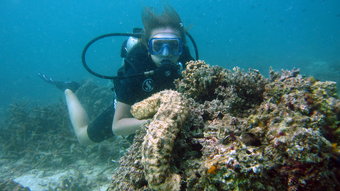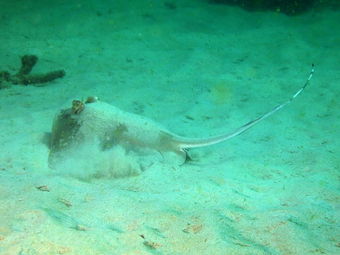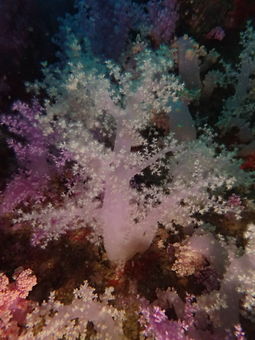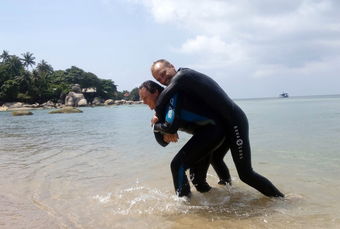- Home
- News
If your child is 8 to 10 years than let him try diving experience on Koh Tao or Samui by taking PADI Bubblemaker program.
Two exited dives with experienced PADI Instructor in Scuba Birds Dive Center!
In PADI Bubblemaker program you kids could go diving for the maximum depth of 2 meters on the most interesting and shallow dive sites around Koh Tao and Nang Yuan Islands, minimum age for this program is 8 years old.
Usually, our dive center Scuba Birds conducts this program on shallow and comfortable dive sites Japanese Garden, Aow Leuk or Mango Bay. Let him try to take the first breath underwater and he will fall in love with diving. from this time PADI Instructor will be his best friend and teacher. It’s not going to be deep dive, however deep enough to see the living of coral reefs and amazing underwater life.
If you child really enjoyed his experience you could get back and take a diving course. PADI Junior Open Water course available from 10 years old. This is a course, so he will learn basic diving knowledge and skills, will be able to go down up to 12 meters. New, interesting dive spots on Koh Tao or Samui will be available for observation.

You can find an amazing and colorful Parrotfish on your diving in Koh Tao at many dive sites.
The parrotfish family contains ten genera and about 90 species. It was named «parrotfishes» because the shape of their teeth resembles a bird’s beak plus the fact they swim with their pectoral fins in a
The teeth of the parrotfish are uniquely designed to scrape algae from coral and rocks. This is its main food source. It is also able to grind up pieces of coral and excrete the indigestible sand. One parrot fish can chew coral into 90 kg of sand each year. Their teeth keep on growing continuously. Some species of parrotfish secrete a mucous envelope to sleep in during the night. This mucous is thought to give it some protection from predators. Some male parrot fish maintain harems of females. If the dominant male dies, one of the females will change gender and color and become the dominant male. The parrotfish plays an important role in the health of the coral reef — it feeds on algae that could smother the coral if left to grow.
Stingrays are found quite frequently while diving in Samui and Koh Tao. There are two main types of stingrays that we see: The Bluespotted Ribbontail stingray (Taeniura lymma) and the Jenkin’s whipray (Himantura Jenkins).
The Bluespotted ray is the more common stingray, it is easily identified by many large brilliant blue spots on a
The Jenkin’s whipray not so common here as the Bluespotted Ribbontail ray, is less colourful than the first one being a more gray or brown colour on the top and white on its underbelly, but it grows to an impressive 1,5 m across and has a broad,
Both rays are more active at night when they can be seen swimming around, hunting for their prey: worms, shrimps and crabs. It’s one big attraction of doing the night adventure dive on your PADI Advanced Open Water course.

Koh Tao diving allows you to see different places and types of dive spots and Shark island, located on the south of Koh Tao is one of the beautiful dive sites in the Gulf of Thailand.
Named after its resemblance to a dorsal fin, Shark Island is a twin rock outcrop consisted of a steeply sloping reef going from 4 meters down to 25 meters, it is situated to the Southeast of Koh Tao which you could see when diving on our Scuba Birds dive boat. Each side of the islet offers a different array of marine life and features making it almost two sites in one! On the East side of the rock you will find a sloping reef with myriad soft corals, gorgonians and sponges, while the Westside offers hard coral formations that are home to moray eels, nudibranchs, snappers, banded angelfish and blue spotted stingrays. Titan triggerfish can be very aggressive here so approach with caution. Whale Sharks are frequently sighted in season along with the odd Turtle and there is also the chance of seeing a few Blacktip reef sharks. This site is also ideal for novice and experienced scuba divers and also for PADI Advanced Open Water Diver course. It offers great snorkeling around Koh Tao as well.
For your convenience in scuba diving in Koh Tao and Samui, one of the great opportunity for many experienced divers is the PADI Rescue Diver course.
Taking place over three days (including the Emergency First Response Primary and Secondary Care) with our experienced instructors in our dive center Scuba Birds in Koh Tao. This course increases your awareness beyond ‘self’ and into ‘global’ awareness. This means that you understand more about responding to other diver’s issues and equipping you with the necessary knowledge to deal with dive emergencies, minor and major, using a variety of techniques learning on shallow dive sites on Koh Tao like Japanese Garden or Mango Bay. It is probably the most physically demanding certification, as it includes recovering unconscious divers from the water a challenging task. All in all, it is a fun and rewarding experience and can make you a much more knowledgeable and responsible diver and make you diving on Koh Tao or Samui safer.



